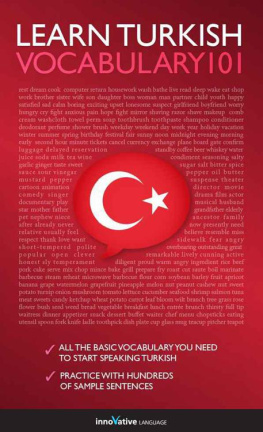hanoum Zeyneb - A Turkish Womans European Impressions
Here you can read online hanoum Zeyneb - A Turkish Womans European Impressions full text of the book (entire story) in english for free. Download pdf and epub, get meaning, cover and reviews about this ebook. year: 2021, publisher: Library of Alexandria, genre: Detective and thriller. Description of the work, (preface) as well as reviews are available. Best literature library LitArk.com created for fans of good reading and offers a wide selection of genres:
Romance novel
Science fiction
Adventure
Detective
Science
History
Home and family
Prose
Art
Politics
Computer
Non-fiction
Religion
Business
Children
Humor
Choose a favorite category and find really read worthwhile books. Enjoy immersion in the world of imagination, feel the emotions of the characters or learn something new for yourself, make an fascinating discovery.

- Book:A Turkish Womans European Impressions
- Author:
- Publisher:Library of Alexandria
- Genre:
- Year:2021
- Rating:4 / 5
- Favourites:Add to favourites
- Your mark:
- 80
- 1
- 2
- 3
- 4
- 5
A Turkish Womans European Impressions: summary, description and annotation
We offer to read an annotation, description, summary or preface (depends on what the author of the book "A Turkish Womans European Impressions" wrote himself). If you haven't found the necessary information about the book — write in the comments, we will try to find it.
A Turkish Womans European Impressions — read online for free the complete book (whole text) full work
Below is the text of the book, divided by pages. System saving the place of the last page read, allows you to conveniently read the book "A Turkish Womans European Impressions" online for free, without having to search again every time where you left off. Put a bookmark, and you can go to the page where you finished reading at any time.
Font size:
Interval:
Bookmark:

She is wearing the Yashmak and Feradj, or cloak.
EUROPEAN IMPRESSIONS
ZEYNEB HANOUM
(HEROINE OF PIERRE LOTIS NOVEL LES DSENCHANTES)
EDITED & WITH AN INTRODUCTION BY
GRACE ELLISON
WITH 23 ILLUSTRATIONS
FROM PHOTOGRAPHS & A DRAWING BY
AUGUSTE RODIN
PHILADELPHIA
J. B. LIPPINCOTT COMPANY
LONDON: SEELEY, SERVICE & CO. LTD.
1913
| CHAP. | PAGE |
| I. | A DASH FOR FREEDOM |
| II. | ZEYNEBS GIRLHOOD |
| III. | BEWILDERING EUROPE |
| IV. | SCULPTURES FORBIDDEN JOY |
| V. | THE ALPS AND ARTIFICIALITY |
| VI. | FREEDOMS DOUBTFUL ENCHANTMENT |
| VII. | GOOD-BYE TO YOUTHTAKING THE VEIL |
| VIII. | A MISFIT EDUCATION |
| IX. | SMART WOMEN THROUGH THE VEIL |
| X. | THE TRUE DEMOCRACY |
| XI. | A COUNTRY PICTURE |
| XII. | THE STAR FROM THE WESTTHE EMPRESS EUGNIE |
| XIII. | TURKISH HOSPITALITYA REVOLUTION FOR CHILDREN |
| XIV. | A STUDY IN CONTRASTS |
| XV. | DREAMS AND REALITIES |
| XVI. | THE MOON OF RAMAZAN |
| XVII. | AND IS THIS REALLY FREEDOM? |
| XVIII. | THE CLASH OF CREEDS |
| XIX. | IN THE ENEMYS LAND |
| XX. | THE END OF THE DREAM |
Zeyneb in her Paris Drawing-room | |
A Turkish Child with a Slave | To face page |
A Turkish House | page |
Les Dsenchantes (by M. Rodin) | page |
A Turkish Dancer | page |
A Turkish Lady dressed as a Greek Dancer | page |
Turkish Lady in Tcharchoff (outdoor costume) | page |
Silent Gossip of a Group of Turkish Women | page |
Turkish Ladies in their Garden with their Childrens Governesses | page |
Yashmak and Mantle | page |
Melek in Yashmak | page |
Zeyneb in her Western Drawing-room | page |
Turkish Ladies paying a Visit | page |
Zeyneb with a black Face-veil thrown back | page |
A Corner of a Turkish Harem of to-day | page |
Turkish Women and Children in the Country | page |
The Balcony at the Back of Zeynebs House | page |
Zeyneb and Melek | page |
The Drawing-room of a Harem showing the Bridal Throne | page |
A Corner of the Harem | page |
A Caque on the Bosphorus | page |
Turkish Women in the Country | page |
Melek on the Verandah at Fontainebleau | page |
Font size:
Interval:
Bookmark:
Similar books «A Turkish Womans European Impressions»
Look at similar books to A Turkish Womans European Impressions. We have selected literature similar in name and meaning in the hope of providing readers with more options to find new, interesting, not yet read works.
Discussion, reviews of the book A Turkish Womans European Impressions and just readers' own opinions. Leave your comments, write what you think about the work, its meaning or the main characters. Specify what exactly you liked and what you didn't like, and why you think so.








